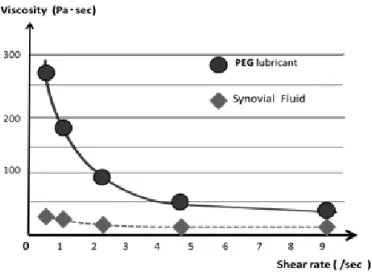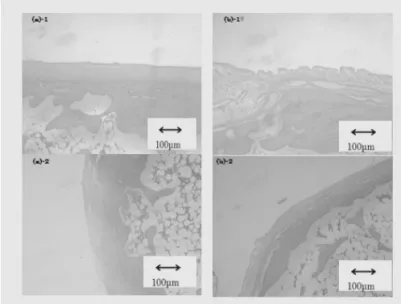大同大学紀要 第50巻(2014)
変形性膝関節症治療のための関節内注入合成潤滑剤用ポリエチレングリコールの in vivo での評価
In vivo trial of Polyethylene Glycol (PEG) as an Artificial Intra-articular Lubricants for Osteoarthritis of the Knee
小林正典
* Masanori Kobayashi
Summary
Although the clinical effect of intra-articular administration of the Hyaluronic Acid (HA) for the treatment of osteoarthritis knee joint has been widely recognized, the efficacy of mechanical tribology function of HA as a viscosupplementation to joint lubrication has not yet been confirmed.
To examine in vivo the effects of enhancement of tribology function of joint lubricant for the treatment of osteoarthritis, high viscous Polyethylene Glycol (PEG) was synthesized as an artificial lubricant, and animal experiment was performed. Experimental osteoarthritis models of the both of knee joints of three rabbits were induced by meniscsectomy and cartilage defects. These animals were subjected to monthly intra-articular cartilage injection of PEG lubricant to one side knee joint ( another side was not injected as a control knee ), and were sacrificed at 3 month after operation. The extracted knee joints were evaluated macroscopically and histologically.
As a results, the PEG injected knees had a tendency to demonstrate less damage of articular cartilage compared with the control group. This finding indicated that the development of mechanical lubricant system by PEG for the preventing of articular cartilage wear could have potential to be one of effective treatment for arthritis.
キーワード:関節内注入、 ポリエチレングリコール、 変形性関節症、トライボロジー
Keywords:Intra-articular administration, Polyethylene Glycol (PEG), Osteoarthritis, Tribology
1. INTRODUCTION
Osteoarthritis (OA), the most common form of arthritis, is a chronic disease characterized by the slow degradation of cartilage, pain and increasing disability. The disease can have an impact on several aspects of a patient's life, including function and activities of daily life, relationships, economic status, body image and emotional wellbeing
1,2).
Orthopedic procedures are important in the management of OA and should not be reserved only for late severe disease.
Although Total knee arthroplasty (TKA) is representative procedure for OA knee associated with severe deformity, current conservative therapies for moderate OA are drug therapy, physical therapy, muscle exercise, and therapy and rehabilitation. These goals of most patients is the relief of
* 工学部総合機械工学科
pain and localized stiffness, as well as the prevention of deformity and associated limitation of motion.
As another treatment of OA knee joint, the intra-articular injection method of high-molecular-weight hyaluronic acid (HA) has recently become more widely accepted for relief from pain. HA is responsible for the viscoelastic properties of synovial fluid, a highly viscous fluid. Its mechanism of action includes two types: one involves the biomechanics system, the enhancement of articular lubrication and fluid viscosity, while the other involves the biological and biochemical system, the inhibition of inflammatory agents such as PGE
2, NO and the suppression of proteoglycan from cartilage matrix
3-5).
This concept of the intra-articular injection of hyaluronic acid for OA is also reasonable given the tribology theoretical background; however, hyaluronic acid is easily degraded in articular joints according to recent studies. Therefore, new materials with excellent biocompatibility, durability, rheology and lubricative function are desired instead of hyaluronic acid.
Against this background, we have synthesized and developed Polyethylene Glycol (PEG) sol as a new intra-articular lubricant for medical treatment for OA knee
6).
In present study, the efficacy of this PEG lubricant has been accessed by the animal experiment using the rabbits.
2.Materials and Methods
2.1 Materials
2.1.1 The fabrication and characteristics of PEG lubricant
PEG is a polymer with the chemical formula HO-(CH2CH2OH) n-H, which refers to a chemical compound composed of repeating ethylene glycol units as shown in Fig.1. It has long been manufactured industrially and utilized in many applications, such as nonionic surfactants, lubricants, as an intermediate for urethane composition, adhesives and cosmetics.
Furthermore, PEG is non-toxic and biocompatible material, PEG is thus also used for bio-related applications, such as pharmaceutical formulations, aqueous two-phase partitions, as a precipitant for plasmid DNA isolation, protein crystallization and cell fusion. We have also paid attention this advantage, attempted to synthesized the PEG lubricant.
Fig.1 The polyethylene glycol (PEG) molecular structure.
As an artificial lubricant, PEG (molecular weight:
2 million) powder was prepared, dissolved in distilled water, heated and synthesized to 6wt.% PEG hydrate sol material, as shown in Figure 2.

